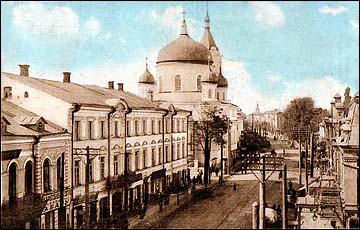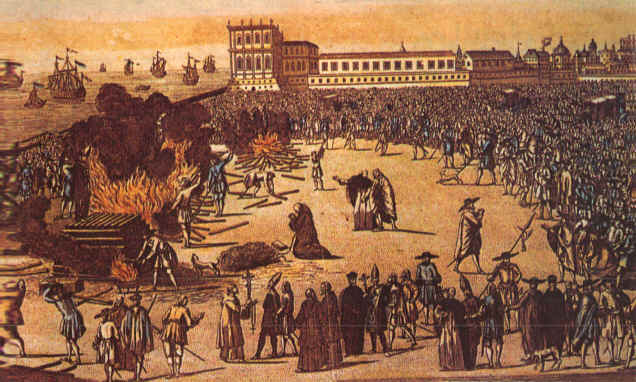|
Aaron Of Cardena
Aaron of Cardena was a Spanish cabalist, about whose life little is known. He wrote a book containing "profound secrets" under the title of ''Ḳarnayim'' ("Rays")—see Hab. iii. 4. The work was erroneously ascribed to Isaac b. Abraham b. David, surnamed "the Blind", which fact shows the esteem in which it was held and also the age in which it was written. The author refers at the close of chap. iii. and at the beginning of chaps. v. and vii. to two of his other works, ''Kitro Yeshu'ah'' ("His Crown is Salvation" — compare Psalm xxxiii. 16), and ''Peraḥ Ẓiẓ'' ("The Blossom of the Priestly Diadem" — compare Num. xvii. 23), the titles of which seem to refer to his name, Aaron, as priest. The work ''Ḳarnayim'' was first published at Zolkiev Zhovkva ( uk, Жовква ; pl, Żółkiew; yi, זאָלקוואַ, translit=Zolkva; russian: Жо́лква, 1951–1992: ''Nesterov'') is a city in Lviv Raion, Lviv Oblast (region) of western Ukraine. Zhovkva hosts the admi ... [...More Info...] [...Related Items...] OR: [Wikipedia] [Google] [Baidu] |
Kabbalah
Kabbalah ( he, קַבָּלָה ''Qabbālā'', literally "reception, tradition") is an esoteric method, discipline and Jewish theology, school of thought in Jewish mysticism. A traditional Kabbalist is called a Mekubbal ( ''Məqūbbāl'' "receiver"). The definition of Kabbalah varies according to the tradition and aims of those following it, from its origin in medieval Judaism to its later adaptations in Western esotericism (Christian Kabbalah and Hermetic Qabalah). Jewish Kabbalah is a set of esoteric teachings meant to explain the relationship between the unchanging, eternal God in Judaism, God—the mysterious ''Ein Sof'' (, ''"The Infinite"'')—and the mortal, finite universe (God's Genesis creation narrative, creation). It forms the foundation of Mysticism, mystical religious interpretations within Judaism. List of Jewish Kabbalists, Jewish Kabbalists originally developed their own transmission of Primary texts of Kabbalah, sacred texts within the realm of Jewish traditio ... [...More Info...] [...Related Items...] OR: [Wikipedia] [Google] [Baidu] |
Isaac The Blind
Isaac the Blind ( he, רַבִּי יִצְחַק סַגִּי נְהוֹר ''Rabbī Yīṣḥaq Saggī Nəhōr'', literally "Rabbi Isaac, blind person"; c. 1160–1235 in Provence, France), was a French rabbi and a famous writer on Kabbalah (Jewish mysticism). The Aramaic epithet "Saggi Nehor" means "of Much Light" in the sense of having excellent eyesight, an ironic euphemism for being blind. Some historians suspect him to be the author of the '' Book of the Bahir'', an important early text of Kabbalah. Others (especially Gershom Scholem, see his Origins of the Kabbalah, p. 253) characterize this view as an "erroneous and totally unfounded hypothesis". Isaac was the son of the famous talmudist, Abraham ben David of Posquières (Raavad). The ''Bahir'' first appeared in the Middle Ages, around 1200 CE in France. It discusses a number of ideas that became important for Kabbalah, and even though the origins of the anonymous work are obscure, there were important Kabbalists who ... [...More Info...] [...Related Items...] OR: [Wikipedia] [Google] [Baidu] |
Diadem
A diadem is a type of crown, specifically an ornamental headband worn by monarchs and others as a badge of royalty. Overview The word derives from the Greek διάδημα ''diádēma'', "band" or "fillet", from διαδέω ''diadéō'', "I bind round", or "I fasten". The term originally referred to the embroidered white silk ribbon, ending in a knot and two fringed strips often draped over the shoulders, that surrounded the head of the king to denote his authority. Such ribbons were also used to crown victorious athletes in important sports games in antiquity. It was later applied to a metal crown, generally in a circular or "fillet" shape. For example, the crown worn by Queen Juliana of the Netherlands was a diadem, as was that of a baron later (in some countries surmounted by three globes). The ancient Celts were believed to have used a thin, semioval gold plate called a ''mind'' (Old Irish) as a diadem. Some of the earliest examples of these types of crowns can be found in ... [...More Info...] [...Related Items...] OR: [Wikipedia] [Google] [Baidu] |
Zolkiev
Zhovkva ( uk, Жовква ; pl, Żółkiew; yi, זאָלקוואַ, translit=Zolkva; russian: Жо́лква, 1951–1992: ''Nesterov'') is a city in Lviv Raion, Lviv Oblast (region) of western Ukraine. Zhovkva hosts the administration of Zhovkva urban hromada, one of the hromadas of Ukraine. Its population is approximately . History A village named ''Winniki'' was mentioned at the site in 1368 and was part of the Kingdom of Poland under the Piast dynasty. The town was founded in 1597 as a private fortified town and named ''Żółkiew'' after its founder, one of the most accomplished military commanders in Polish history, hetman Stanisław Żółkiewski. Like Zamość, which was founded by Żółkiewski's mentor Jan Zamoyski, Żółkiew was built on an ideal Renaissance city plan. Due to its strategic location at the intersection of important trade routes, the town prospered.Ruth Ellen Gruber.For a fortress town, a second renaissance. January 12, 2009. The New York Times. ... [...More Info...] [...Related Items...] OR: [Wikipedia] [Google] [Baidu] |
Samson Ben Pesah Ostropoli
Samson ben Pesah Ostropoli (died July 15, 1648), was a Jews of Poland, Polish rabbi from Ostropol who was martyred at Polonnoye, Volhynia, during the Khmelnytsky Uprising. When the Cossacks laid siege to Polonnoye, Samson, with 300 of his followers, arrayed in their shrouds and tallit, praying-shawls, went to the synagogue, and stood there praying until the enemy came and butchered them all. Ostropoli was a noted kabalist. He was the author of a commentary (published by his nephew Pesaḥ at Zolkiev in 1709) on the kabalistic work ''Ḳarnayim.'' According to the author of ''Yewen Meẓulah,'' he wrote also a commentary on the Zohar, titled ''Machane Dan,'' in conformity with the cabalistic system of Isaac Luria, but this work has not been preserved. Other works of his are: Dan Yadin, a commentary on an early cryptic kabalistic work called Sefer Karnayim. A collection of all Rabbi Shimshon's known Torah commentaries called Nitzotzay Shimshon. His most famous work is the Erev (eve of ... [...More Info...] [...Related Items...] OR: [Wikipedia] [Google] [Baidu] |
Jitomir
Zhytomyr ( uk, Жито́мир, translit=Zhytomyr ; russian: Жито́мир, Zhitomir ; pl, Żytomierz ; yi, זשיטאָמיר, Zhitomir; german: Schytomyr ) is a city in the north of the western half of Ukraine. It is the administrative center of Zhytomyr Oblast (province), as well as the administrative center of the surrounding Zhytomyr Raion (district). The city of Zhytomyr is not a part of Zhytomyr Raion: the city itself is designated as its own separate raion within the oblast; moreover Zhytomyr consists of two so-called "raions in a city": Bohunskyi Raion and Koroliovskyi Raion (named in honour of Sergey Korolyov). Zhytomyr occupies an area of . Its population is Zhytomyr is a major transport hub. The city lies on a historic route linking the city of Kyiv with the west through Brest. Today it links Warsaw with Kyiv, Minsk with Izmail, and several major cities of Ukraine. Zhytomyr was also the location of Ozerne airbase, a key Cold War strategic aircraft base south ... [...More Info...] [...Related Items...] OR: [Wikipedia] [Google] [Baidu] |
Livorno
Livorno () is a port city on the Ligurian Sea on the western coast of Tuscany, Italy. It is the capital of the Province of Livorno, having a population of 158,493 residents in December 2017. It is traditionally known in English as Leghorn (pronounced , "Leghorn" in the . or ). During the , Livorno was designed as an "". Developing c ... [...More Info...] [...Related Items...] OR: [Wikipedia] [Google] [Baidu] |
18th-century Spanish People
The 18th century lasted from January 1, 1701 ( MDCCI) to December 31, 1800 ( MDCCC). During the 18th century, elements of Enlightenment thinking culminated in the American, French, and Haitian Revolutions. During the century, slave trading and human trafficking expanded across the shores of the Atlantic, while declining in Russia, China, and Korea. Revolutions began to challenge the legitimacy of monarchical and aristocratic power structures, including the structures and beliefs that supported slavery. The Industrial Revolution began during mid-century, leading to radical changes in human society and the environment. Western historians have occasionally defined the 18th century otherwise for the purposes of their work. For example, the "short" 18th century may be defined as 1715–1789, denoting the period of time between the death of Louis XIV of France and the start of the French Revolution, with an emphasis on directly interconnected events. To historians who expand ... [...More Info...] [...Related Items...] OR: [Wikipedia] [Google] [Baidu] |
Spanish Jews
Spanish and Portuguese Jews, also called Western Sephardim, Iberian Jews, or Peninsular Jews, are a distinctive sub-group of Sephardic Jews who are largely descended from Jews who lived as New Christians in the Iberian Peninsula during the immediate generations following the forced expulsion of unconverted Jews from Spain in 1492 and from Portugal in 1497. Although the 1492 and 1497 expulsions of unconverted Jews from Spain and Portugal were separate events from the Spanish and Portuguese Inquisitions (which were established over a decade earlier in 1478), they were ultimately linked, as the Inquisition eventually also led to the fleeing out of Iberia of many descendants of Jewish converts to Catholicism in subsequent generations. Despite the fact that the original Edicts of Expulsion did not apply to Jewish-origin New Christian '' conversos'' —as these were now legally Christians— the discriminatory practices that the Inquisition nevertheless placed upon them, whi ... [...More Info...] [...Related Items...] OR: [Wikipedia] [Google] [Baidu] |





